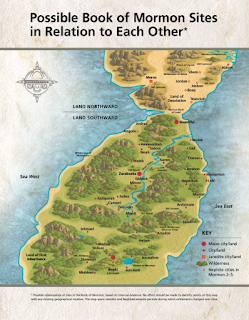| CES fantasy map |
To be sure, these faithful LDS teachers are trying to persuade students to believe that the Book of Mormon is “internally consistent” because they can make sense of all the geography passages.
They are also trying to persuade students to believe M2C. If they come right out and say “the prophets were wrong about the New York Cumorah,” at least a few students will resist. Instead, they teach this principle indirectly by portraying Cumorah in a place that is anything but New York.
And, of course, they are trying to indoctrinate students in the M2C interpretation so that students will embrace the M2C application to Mesoamerica taught by Book of Mormon Central and other members of the M2C citation cartel.
But what do these models actually persuade people to believe?
 |
| BYU fantasy map |
You don’t need more than a quick glance to realize these maps are ridiculous because it fits no place on earth.
Worse, it’s a place that contradicts the teachings of the prophets about the New York Cumorah.
The other tragedy is this: many Church members do not know, and will never learn, that there are interpretations of the text that not only corroborate and support what the prophets have taught about the New York Cumorah, but are also consistent with extrinsic evidence from archaeology, anthropology, geology, geography, etc.
 The original M2C map was developed by an RLDS scholar named L.E. Hills, who published his version in 1917.
The original M2C map was developed by an RLDS scholar named L.E. Hills, who published his version in 1917. He moved Cumorah to southern Mexico, highlighted by the red circle.
It was this map and the associated analysis that led Joseph Fielding Smith to issue his warning. He repeated his warning when he was President of the Quorum of the Twelve Apostles, but it didn’t matter.
 Probably the best-known version was created by Brother Sorenson, one of the M2C triumvirate. The other two members of the triumvirate endorsed the Sorenson map.
Probably the best-known version was created by Brother Sorenson, one of the M2C triumvirate. The other two members of the triumvirate endorsed the Sorenson map. The news is full of public discussion about the corona virus models used by public health experts to influence public policy. The models projected millions of deaths and led government officials to lock down national economies around the world.
https://fivethirtyeight.com/features/why-its-so-freaking-hard-to-make-a-good-covid-19-model/
After persuading President Trump to shut down the economy by relying on early models, Dr. Fauci said recently, “I have always been and still am and will always be somewhat reserved and skeptical of models because models are only as good as the assumptions that you put into the models.”
_____
The M2C maps taught by CES and BYU also merely reflect the assumptions and preferences of the people who made the models.
These maps expressly repudiate the teachings of the prophets about the New York Cumorah.
As more and more Church members learn what the prophets have taught, and how extrinsic evidence supports and corroborates those teachings, they, too, will shed their misplaced trust in the validity of the M2C model.
Source: About Central America

